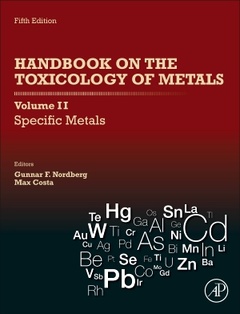Handbook on the Toxicology of Metals: Volume II: Specific Metals (5th Ed.) Specific Metals
Coordonnateurs : Nordberg Gunnar F., Costa Max

Handbook on the Toxicology of Metals, Volume II: Specific Metals, Fifth Edition provides complete coverage of 38 individual metals and their compounds. This volume is the second volume of a two-volume work which emphasizes toxic effects in humans, along with discussions on the toxic effects of animals and biological systems in vitro when relevant. The book has been systematically updated with the latest studies and advances in technology. As a multidisciplinary resource that integrates both human and environmental toxicology, the book is a comprehensive and valuable reference for toxicologists, physicians, pharmacologists, and environmental scientists in the fields of environmental, occupational and public health.
1. Aluminum 2. Antimony 3. Arsenic 4. Barium 5. Beryllium 6. Bismuth 7. Cadmium 8. Chromium 9. Cobalt 10. Copper 11. Gadolinium 12. Gallium and gallium semiconductor compounds 13. Germanium 14. Gold and Gold mining 15. Indium 16. Iridium 17. Iron 18. Lanthanum 19. Lead 20. Lithium 21. Manganese 22. Mercury 23. Molybdenum 24. Nickel 25. Osmium 26. Palladium 27. Platinum 28. Rhodium 29. Selenium 30. Silver 31. Tellurium 32. Thallium 33. Tin 34. Titanium 35. Tungsten 36. Uranium 37. Vanadium 38. Zinc
- Contains peer-reviewed chapters that deal with the effects of metallic elements and their compounds on biological systems with a focus on human health effects
- Includes information on sources, transport, and the transformation of metals in the environment
- Provides critical information on the properties, use, biological monitoring, dose-response relationships, diagnosis, treatment, and prevention of 38 metallic elements and their compounds
Date de parution : 12-2021
Ouvrage de 1052 p.
21.5x27.6 cm
Thèmes de Handbook on the Toxicology of Metals: Volume II... :
Mots-clés :
5-Aminolevulinic acid synthase (ALA-S1 and 2); Absorption; Adverse effects; Allergic hypersensitivity; Allergic reaction; Aluminum; Analysis; Antimony; Antiparasitic; Antirheumatic drugs; Aquaporin-2; Arsenic; Arsenic biomonitoring; Arsenic epidemiology studies; Arsenic induced cancer; Arsenic methylation; Arsenic toxicity; Arsine; Asthma; ATP7A; ATP7B; Barium; Barium sulfate; Batteries; Berylliosis; Beryllium; Biological half-life of Cd; Biological monitoring; Biological monitoring of Cd; Bipolar disorders; Bismuth nanoparticles; Bismuth subgallate; Bismuth subnitrate; Bismuth subsalicylate; Bismuth telluride; Blood pressure; Bone diseases; Bone mineral density and Cd; Cadmium toxicokinetics; Cancer therapy; Carbon disulfide; Carcinogenesis of Cd; Carcinogenic potency; Carcinogenicity; Carcinogenicity tests; Cardiovascular; Cardiovascular disease; Cardiovascular diseases; Central nervous system diseases; Ceruloplasmin; Chronic beryllium disease



